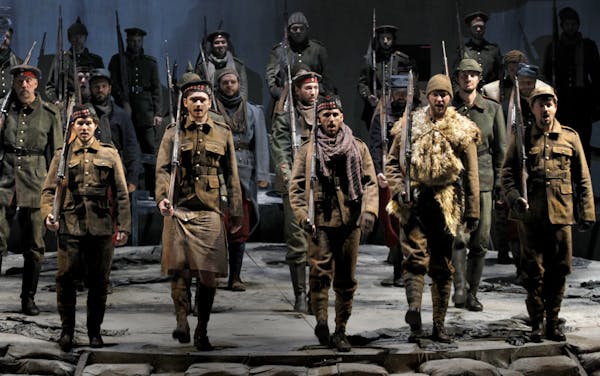My grandpa was there. In a trench, covered in mud and lice, ankle-deep in blood and human waste. But he was alive at 11 a.m. on Nov. 11, 1918. And because of that, I am here, 100 years later, to honor all who served in the Great War.
It's impossible not to think of my Grandpa Eastman each time I see the flame burning atop the Liberty Memorial Tower in Kansas City, Mo., or when I walk across the field of poppies to the city's National World War I Museum. It reminds me that war is intimate and personal and life-altering. And that this war, Grandpa's war, still has consequences today.
The consequences of that war, of all wars and violence in our world, in our own communities, motivated artist Ada Koch to create and shape by hand 117 red poppies out of 20-gauge steel for the 100th anniversary of the Armistice.
"It's certainly not a glorification of war," said Koch. "It's a symbol of remembrance, about hope and rebirth after the destruction of war."
Each of the 117 poppies represents 1,000 Americans who died in the Great War, including 26,277 during the Meuse-Argonne Offensive that began on Sept. 26, 1918, and continued until the Treaty of Versailles was signed. It remains the largest and deadliest battle in U.S. history. My grandpa was there.
Just beyond the reflection pool where these poppies cascade into a wave, and inside the massive steel doors under the memorial, an additional field of 9,000 poppies, each one representing 1,000 people who died in Europe from 1914 to 1918, silently measures for us the immeasurable cost of war.
Poppies have become the global symbol of World War I thanks to the enduring poem by Lt. Col. John McCrae, a Canadian surgeon in Flanders, Belgium, who saw the worst of the war and tried to repair it.
Because of his tender words "In Flanders Fields, the poppies blow, between the crosses, row and row," images of red poppies are now being illuminated on the exterior of the National World War I Museum and Liberty Memorial from sunset to sunrise through Nov. 11.
Look for the new display of names of all who died in combat in 1918. It is part of a four-year global project coordinated by the National World War I Museum to honor those who died. It is also the first comprehensive list of all American soldiers who were killed during World War I.
My grandpa's name, Sgt. Wilbert Eastman, is not on that list, but it is on a memorial brick in the Walk of Honor as you approach the museum.
Best in the world
When my sister and I visited the battlefields in France where Grandpa served, we met and became friends with a French woman, a historian, who was delighted to learn that I was from Kansas City. She had heard of our museum, home to the world's largest collection of World War I artifacts.
She later visited Kansas City, spending three days reading every word in the exhibits, spending hours in the research center, and leaving the U.S. in awe of this collection. Better than anything on the European continent, she told us.
Since then, a new art gallery has been developed that showcases the visual art of the era. The Wylie Gallery opened in February with the massive installation of "Gassed" by John Singer Sargent, a painting that attempted to communicate the horrors of chemical warfare.
My grandpa, too, experienced a mustard gas attack like that portrayed in this remarkable mural.
The famous painting is now back at the Imperial War Museum in London, and the current exhibit in Kansas City focuses on the American Jewish experience in World War I.
An estimated 250,000 Jews served with the American Expeditionary Forces, including composer Irving Berlin. His draft card is among the items on display, as well as handwritten drafts of the Balfour Declaration, the July 1917 document that outlined British support for the establishment of Israel. This exhibit ends Nov. 11.
Armistice commemoration
Armistice Day, as my grandma always called it, became known as Veterans Day in the U.S. in 1954. At 9:30 a.m. on Nov. 11 (next Sunday), music and speakers will precede the laying of a wreath of poppies at the base of the Liberty Memorial.
At 10:45 a.m., bells will begin to toll throughout Kansas City and around the world.
At 11 a.m., 100 years ago, fighting ceased.
It would be another seven months before my grandpa was back home with my grandmother in Union County, Ill.; seven months in which he endured the Spanish flu, suffering with no medication and only an army blanket for warmth on a floor in an abbey in Flavigny-sur-Ozerain, France.
But he came home and fathered six children, including my mother. He earned a living as a carpenter, tended a garden and attended church while teaching his grandchildren to love Dilly Bars and the St. Louis Cardinals. This grandchild was 12 years old when he died.
That's why I will be at the National World War I Museum in Kansas City at 11 a.m. on Nov. 11, placing my hand over my heart and facing east, as my grandmother taught us to do, to give thanks for my grandpa and all of those who served in "the war to end all wars."
More information
The National World War I Museum's Armistice Commemoration runs through Nov. 11. Admission to the museum and memorial (normally $10-$16) is free for veterans and active-duty military personnel Nov. 9-11, and half-price for the general public. More info at theworldwar.com.
Diana Lambdin Meyer is a travel writer based in Kansas City.

Minnesota and other Democratic-led states lead pushback on censorship. They're banning the book ban

